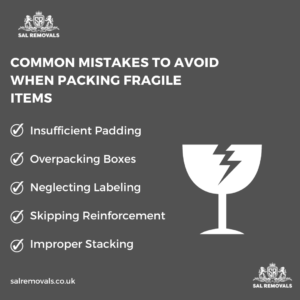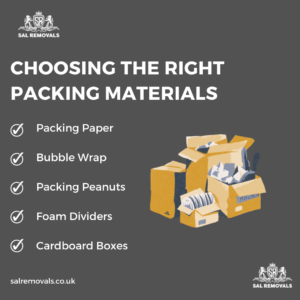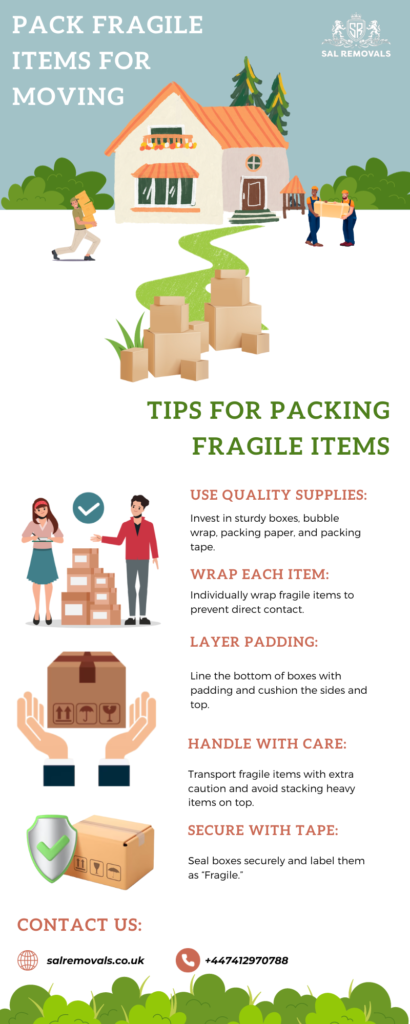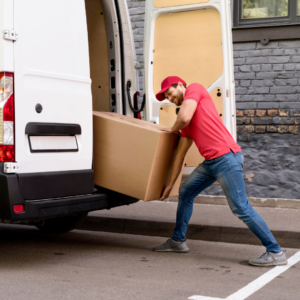Fragile items are objects or possessions that are easily breakable, often due to their delicate nature, material composition, or sentimental value. These can include glassware, ceramics, electronics, antiques, artwork, or even personal keepsakes. Fragile items require special handling and packaging to prevent damage during transport or storage.
Why is it Important to Pack Fragile Items Carefully for Moving?
Packing fragile items carefully for a move is crucial to ensure their safe arrival at the destination. Mishandling during transportation can lead to irreparable damage or loss, resulting in financial and emotional distress. Proper packing safeguards delicate items from shocks, vibrations, and impacts, preserving their integrity and value.
Common Mistakes to Avoid When Packing Fragile Items
Insufficient Padding: Failing to provide enough cushioning material like bubble wrap or foam can lead to items touching and breaking.
Overpacking Boxes: Overloading boxes with fragile items makes them more susceptible to damage.
Neglecting Labeling: Not clearly labeling fragile boxes can lead to mishandling.
Skipping Reinforcement: Reinforcing boxes with tape and additional padding is often overlooked.
Improper Stacking: Placing heavy items atop fragile ones can result in crushing.
Tips for Packing Fragile Items Safely
Here’s the tips for packing fragile items safely within the UK;
Use Quality Supplies: Invest in sturdy boxes, bubble wrap, packing paper, and packing tape.
Wrap Each Item: Individually wrap fragile items to prevent direct contact.
Layer Padding: Line the bottom of boxes with padding and cushion the sides and top.
Secure with Tape: Seal boxes securely and label them as “Fragile.”
Handle with Care: Transport fragile items with extra caution and avoid stacking heavy items on top.
Choosing the Right Packing Materials
Selecting the appropriate packing materials is essential for safeguarding your belongings during a move. Each item you pack may have unique requirements, and understanding which materials to use can make a significant difference in ensuring they arrive at their destination intact.
Packing Paper
Packing paper is a versatile and cost-effective material for wrapping delicate items. To use it effectively, crumple sheets of packing paper and place them at the bottom of boxes for cushioning. Wrap individual items, like dishes or glassware, tightly in multiple layers of paper. This extra layering provides protection against shocks and vibrations during transit.
Bubble Wrap
Bubble wrap is excellent for items that require extra cushioning and protection. Wrap your fragile items in bubble wrap, making sure to leave no exposed areas. Secure the wrap with tape. For added safety, consider double-wrapping extremely delicate objects. Always place bubble-wrapped items upright within boxes, ensuring minimal movement.
Packing Peanuts
Packing peanuts are lightweight and provide excellent cushioning for fragile items. Pour a layer of peanuts at the bottom of the box, place the wrapped items on top, and fill the remaining space with more peanuts. Shake the box gently to allow peanuts to settle, ensuring items stay snug in place.
Foam Dividers
Foam dividers are ideal for separating and protecting dishes and glassware. Place foam dividers between each item to prevent them from touching. Stack the items vertically inside a sturdy box, and fill any gaps with additional foam or packing paper.
Cardboard Boxes
Choose sturdy cardboard boxes in various sizes to accommodate your items. Ensure the boxes are clean and in good condition. Always reinforce the bottom of each box with packing tape to prevent items from falling through during the move.
Packing Fragile Items
Packing fragile items requires care and attention to ensure they reach your new location without damage. Here, we’ll delve into specific instructions on how to pack various delicate belongings, from glasses and mugs to electronics and furniture.
How to Pack Glasses and Mugs
Properly packing your glassware and mugs is essential to prevent breakage during your move.
Gather Supplies: You’ll need packing paper, bubble wrap, and sturdy boxes.
Wrap Individually: Start by crumpling a sheet of packing paper and placing it inside the glass or mug. Wrap each item in a layer of bubble wrap, securing it with tape.
Layer in Boxes: Place a layer of crumpled packing paper at the bottom of the box for cushioning. Arrange the glasses or mugs vertically, filling any gaps with more packing paper.
Label Clearly: Label the box as “Fragile” and indicate its contents. This ensures careful handling.
How to Pack Plates and Bowls
With the right technique, your plates and bowls can withstand the journey without chipping or cracking.
Supplies: You’ll need packing paper and sturdy boxes.
Layer and Wrap: Place a stack of plates in the center of a sheet of packing paper. Fold the sides over and stack another set. Continue until you have a bundle, then wrap it tightly. Do the same for bowls.
Cushion the Box: Line the bottom of the box with crumpled packing paper. Place the wrapped plates and bowls upright, adding more paper between layers.
Label Clearly: Label the box as “Fragile” and specify the contents.
How to Pack Vases and Other Hollow Items
Safeguard your fragile hollow items like vases by following these packing guidelines.
Supplies: Gather packing paper, bubble wrap, and a box.
Wrap and Fill: Wrap the vase in bubble wrap and secure with tape. Fill the hollow space with crumpled packing paper to prevent collapsing.
Box Securely: Place the vase in a box that fits snugly. Use extra paper or bubble wrap to fill gaps.
Label Carefully: Label the box as “Fragile – Hollow Item.”
How to Pack Picture Frames and Artwork
Preserve your precious artwork and picture frames by packing them securely.
Supplies: Use bubble wrap, cardboard, and a sturdy box.
Protect the Frame: Wrap the frame in bubble wrap, then slide a piece of cardboard on each side. Secure with tape.
Box and Secure: Place the framed artwork in a box with additional cardboard on the sides. Fill gaps with packing paper.
Label Precisely: Label the box “Fragile – Artwork” and indicate which side should be up.
How to Pack Electronics
Ensure your electronics arrive in working condition by packing them correctly.
Supplies: For smaller electronics, use bubble wrap and sturdy boxes. For larger ones, consider original packaging if available.
Wrap and Box: Wrap the electronic item in bubble wrap and secure with tape. Place it in a well-fitting box, cushioned with packing paper or bubble wrap.
Label with Details: Label the box with the contents, such as “Flat-screen TV” or “Stereo System,” and indicate which end should be up.
How to Pack Furniture
Packing furniture requires disassembly, if possible, and ample padding with blankets or furniture covers. Remove legs and hardware, and wrap each piece securely before transporting it to protect against scratches and dents.
Loading and Unloading Fragile Items
Transporting fragile items safely involves not only packing them securely but also handling them with care during the loading and unloading processes. Here’s how to load and unload fragile items effectively to ensure they remain intact throughout your move.
How to Load Fragile Items into a Moving Truck
Prepare the Truck: Ensure the moving truck is clean and dry. Lay down furniture blankets or padding to create a cushioned surface.
Prioritize Placement: Fragile items should go in last to minimize shifting during transit. Place heavier, sturdier items on the bottom to create a stable foundation.
Use Tie-Downs: Utilize straps, ropes, or bungee cords to secure fragile items in place. Attach them to the truck’s anchor points or use the logistics tracks if available.
Create Barriers: If you have a significant number of fragile items, consider creating barriers using cardboard or furniture to keep them from moving around.
Even Distribution: Distribute the weight evenly across the truck, placing fragile items towards the back and sides. Use additional padding or furniture blankets to separate them from other items.
Secure Boxes: If you’ve packed fragile items in boxes, make sure they’re tightly sealed and labeled “Fragile” to alert movers to handle them with care.
How to Unload Fragile Items from a Moving Truck
Plan Ahead: Before unloading, assess the placement of fragile items inside the truck. Identify the order in which they should be removed.
Teamwork: If possible, have a small team to help with unloading. This can reduce the risk of accidents and provide extra hands to handle delicate items.
Gentle Handling: Carefully remove each fragile item, using proper lifting techniques. Avoid tossing or dropping items.
Designated Area: Designate a safe, flat area where fragile items can be placed as they are removed from the truck. Use additional padding or blankets as needed.
Check for Damage: Inspect each item as it’s unloaded. If any damage is observed, document it for insurance purposes.
Storing Fragile Items: Once unloaded, store fragile items in a secure location in your new home, away from heavy traffic areas or potential hazards.
Conclusion
Packing fragile items for a move in the UK can be a meticulous process, but it’s essential for safeguarding your precious possessions. By following these guidelines and taking the necessary precautions, you can significantly reduce the risk of damage during your move.
FAQs
Can I use newspapers instead of packing paper for wrapping fragile items?
While newspapers are an option, they may leave ink stains on your belongings. It’s safer to use packing paper or bubble wrap.
What should I do if I can’t find sturdy boxes for packing?
Consider asking local businesses or supermarkets for sturdy boxes or invest in high-quality plastic containers.
Are there any specific regulations for packing fragile items when moving internationally to the UK?
Yes, when moving internationally, it’s crucial to check customs regulations and consult with your moving company for guidance on packing fragile items.
Should I disassemble fragile furniture before moving?
Yes, disassembling fragile furniture can help protect it during the move. Keep screws and small parts in labeled bags.
Is it worth purchasing insurance for fragile items during a move?
Yes, insurance provides an extra layer of protection for your fragile items in case of accidents or damage during transit. Nowadays, Modern removal companies also extend insurance options for fragile items. Contact them to learn more and ensure the protection of your valuables.







